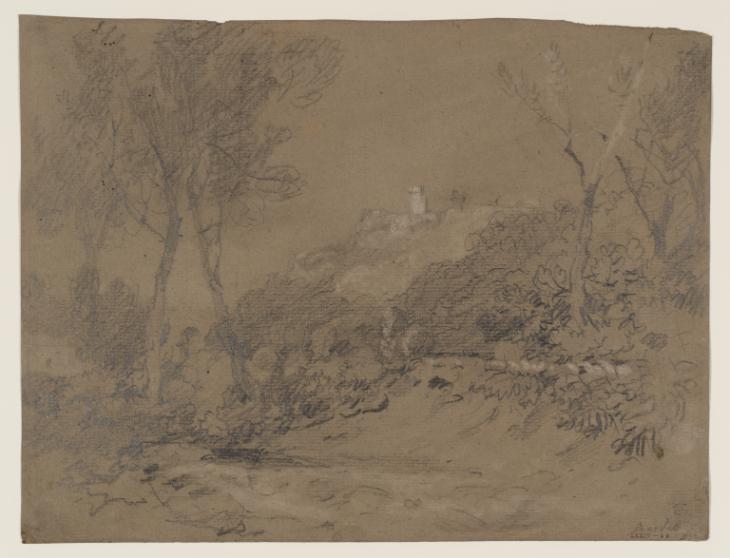Joseph Mallord William Turner ?Martigny; La Bâtiaz from the River Drance 1802
Joseph Mallord William Turner,
?Martigny; La Bâtiaz from the River Drance
1802
Joseph Mallord William Turner 1775–1851
?Martigny; La Bâtiaz from the River Drance 1802
D04552
Turner Bequest LXXIV 59
Turner Bequest LXXIV 59
Pencil, black chalk and white gouache on greyish-buff laid paper, 217 x 283 mm
Inscribed by Turner in pencil ?‘Martig...’ bottom right
Stamped in black ‘LXXIV 59’ bottom right
Blind-stamped with the Turner Bequest monogam bottom right
Inscribed by Turner in pencil ?‘Martig...’ bottom right
Stamped in black ‘LXXIV 59’ bottom right
Blind-stamped with the Turner Bequest monogam bottom right
Accepted by the nation as part of the Turner Bequest 1856
Exhibition history
1879
Oxford Loan Collection, University Galleries, Oxford, 1879 until at least 1909 (37, as ‘Tower on Hill. Mine’; 111a, as ‘Tower on Hill. Original of Dark Pastoral’).
1998
Turner in the Alps 1802, Tate Gallery, London, November 1998–February 1999, Fondation Pierre Gianadda, Martigny, March–June 1999 (39, as ‘Morgex, Val d’Aosta, with the Castle of Châtelard’).
References
1904
E.T. Cook and Alexander Wedderburn (eds.), Library Edition: The Works of John Ruskin: Volume XIII: Turner: The Harbours of England; Catalogues and Notes, London 1904, p.458 note 1.
1909
A.J. Finberg, A Complete Inventory of the Drawings of the Turner Bequest, London 1909, vol.I, p.199, LXXIV 59, as ‘Tower on Hill...’.
1983
Andrew Wilton, ‘Scene in Savoy. c.1816’, Picture Notes, Turner Studies, vol.3, no.1, Summer 1983, pp.57–8.
1990
Peter Bower, Turner’s Papers: A Study of the Manufacture, Selection and Use of his Drawing Papers 1787–1820, exhibition catalogue, Tate Gallery, London 1990, pp.82–3 note 5.
1998
David Blayney Brown, Turner in the Alps 1802, exhibition catalogue, Tate Gallery, London 1998, pp.120–1 reproduced in colour, as ‘Morgex, Val d’Aosta, with the Castle of Châtelard’.
1999
David Blayney Brown, Turner et les Alpes 1802, exhibition catalogue, Fondation Pierre Gianadda, Martigny 1999, pp.120–1 reproduced in colour.
1999
David Hill, ‘Turner in the Alps’, Turner Society News, no.81, March 1999, p.5.
There is at least one other slighter version of this subject from the same sketchbook (D04541; Turner Bequest LXXIV 48), and perhaps another, called Martigny by Finberg (D04557; Turner Bequest LXXIV 64). John Ruskin’s first title for the present drawing, ‘Tower on Hill. Mine’, reflected its being the same composition as a watercolour in his collection (Wolverhampton Art Gallery)1 whose original title was not recorded2 but which he lent to the Fine Art Society, London in 1878 as ‘Italy of the Olden Time’. This watercolour seems to have been made for Sir William Pilkington, who may have chosen the subject at the same time as his friend Walter Fawkes made his own choices from Turner’s 1802 drawings. Subsequently Ruskin renamed it ‘Dark Pastoral’ and then ‘Scene in Savoy’. Lending the watercolour under the last title to an exhibition at Douglas in 1880, Ruskin wrote about the Bequest drawing in the catalogue: ‘the pencil sketch is in a group of early ones lent by the National Gallery Trustees to Oxford. I found the sketch in arranging the series for Oxford, having before mistakenly described the scene as in Italy in my notes on my Turner exhibition. The drawing is one of much earlier date... and in Turner’s grandest classical manner; the trees, however, not yet rightly drawn, but more or les copied from Poussin.’3
Evidently, Ruskin did not know the exact subject, and discussing the watercolour at the time of its acquisition by Wolverhampton, Andrew Wilton was also unable to identify it.4 For the 1999 Tate/Martigny exhibition, the present writer suggested that the drawing catalogued here depicted Morgex, in the Valdigne, on the basis of the puzzling or incomplete inscription5 which Finberg read as ‘“Marlec” – or “Mardu” or “Mardec”’. This location was afterwards rejected by David Hill.6 On further reflection it seems more likely that Turner’s inscription refers to Martigny, in which case the subject would be a classicised view of the Castle of La Bâtiaz from the River Drance. Any resemblance to Martigny and its castle is stronger in the drawings than in the watercolour, which is even more idealised, especially in the foreground. The identification remains tentative.
After Pilkington this watercolour belonged to John Dillon at whose sale it was bought for Ruskin by Vokins; see Evelyn Joll, ‘Dillon, John’, in Evelyn Joll, Martin Butlin and Luke Herrmann eds., The Oxford Companion to J.M.W. Turner, Oxford 2001, p.77; Ruskin on Pictures, London 1902, pp.342, 437.
Verso:
Laid down
David Blayney Brown
September 2011
How to cite
David Blayney Brown, ‘?Martigny; La Bâtiaz from the River Drance 1802 by Joseph Mallord William Turner’, catalogue entry, September 2011, in David Blayney Brown (ed.), J.M.W. Turner: Sketchbooks, Drawings and Watercolours, Tate Research Publication, August 2014, https://www

